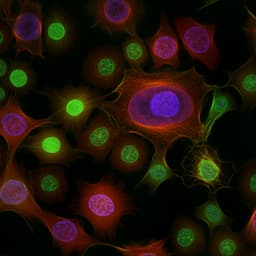
Medicine and Health
Baseline ctDNA gene alterations as a biomarker of survival after panitumumab and chemotherapy in metastatic colorectal cancer
K. Shitara, K. Muro, et al.
In the exciting Phase 3 PARADIGM trial involving 733 participants, researchers investigated how circulating tumor DNA (ctDNA) gene alterations impact treatment outcomes in RAS wild-type metastatic colorectal cancer. Discover whether first-line therapy using panitumumab could provide longer survival rates for patients without ctDNA alterations, as highlighted by the team of experts led by Kohei Shitara and Kei Muro.
~3 min • Beginner • English
Introduction
For unresectable RAS wild-type metastatic colorectal cancer (mCRC), standard first-line therapy is chemotherapy combined with either an anti-EGFR antibody (panitumumab or cetuximab) or an anti-VEGF antibody (bevacizumab). The phase 3 PARADIGM trial showed longer overall survival (OS) with panitumumab+mFOLFOX6 versus bevacizumab+mFOLFOX6, particularly in left-sided primary tumors, while outcomes were poorer for right-sided tumors. Primary resistance to EGFR inhibition is associated with specific tumor genomic and molecular profiles (for example, BRAF V600E mutations and MSI-H), and current guidelines recommend selecting anti-EGFR therapy based on primary tumor location, RAS and BRAF mutation status, and mismatch repair/MSI status. However, additional, less common alterations (PTEN, EGFR extracellular domain mutations, HER2 and MET amplifications, and ALK/RET/NTRK1 fusions) have also been implicated in resistance. This study investigates whether baseline plasma ctDNA-based negative hyperselection—absence of a broad panel of resistance-associated alterations—predicts improved outcomes with first-line panitumumab-based therapy versus bevacizumab-based therapy, and whether this approach refines selection beyond tumor sidedness and current guideline biomarkers.
Literature Review
Prior work and guidelines have established the predictive value of primary tumor sidedness and gene markers (RAS, BRAF, MSI/MMR) for anti-EGFR benefit in mCRC. Studies have linked rare alterations (PTEN mutations, EGFR ECD mutations, HER2 or MET amplification, and ALK/RET/NTRK1 fusions) to primary resistance to EGFR inhibitors. Tissue-based panels combining multiple resistance-associated markers enabled a "negative hyperselection" strategy that better predicted anti-EGFR benefit than individual markers alone. Liquid biopsy via ctDNA offers a minimally invasive alternative to tissue genotyping, potentially capturing tumor heterogeneity and enabling broader biomarker assessment. This analysis extends prior negative hyperselection concepts to a large randomized phase 3 cohort using a ctDNA panel, and compares its predictive performance to current guideline-recommended biomarker stratification (RAS/BRAF and MSI status).
Methodology
Design and population: PARADIGM (NCT02394795) was a randomized, open-label, phase 3 trial across 197 sites in Japan (May 2015–January 2022). Eligible patients were 20–79 years old with unresectable adenocarcinoma of the colorectum, RAS wild-type by approved tissue assays (KRAS/NRAS exons 2, 3, 4), ECOG PS 0–1, and at least one evaluable lesion (RECIST v1.1). Patients received first-line therapy and were randomized 1:1 to panitumumab+mFOLFOX6 or bevacizumab+mFOLFOX6, stratified by site, age (20–64 vs 65–79), and presence of liver metastases. The primary endpoint of the main trial was OS, tested hierarchically in left-sided tumors and then overall; secondary endpoints included PFS, response rate, duration of response, and curative resection rate; depth of response was exploratory. Data cutoff: 14 January 2022.
Biomarker substudy: Of 802 in the efficacy analysis set, 742 consented to biomarker analyses; 733 had evaluable baseline plasma and ctDNA (91.4% of trial efficacy population). Follow-up medians were 61.4 months (panitumumab arm) and 60.5 months (bevacizumab arm).
ctDNA assay: Baseline plasma ctDNA was analyzed using a custom NGS panel (PlasmaSELECT-R 91, Personal Genome Diagnostics). The panel targets 90 mutations, 26 amplifications, and 3 rearrangements in mCRC-related genes and assesses MSI. Analytical sensitivity: 92% (MAF 0.10%) and 83% (MAF 0.20%) for sequence mutations; 100% for high-level focal amplifications (20% tumor purity), 100% for translocations (0.10% tumor purity), and 100% for MSI (0.50% tumor purity). Specificity was 99.9998%–100% depending on alteration type; reproducibility 100% for specimens meeting acceptance criteria. Targeted regions spanned 250 kb. HER2 amplification calling used a 1.25 threshold based on normal-sample noise.
Definitions: Negative hyperselected = ctDNA negative for all prespecified alterations linked to EGFR resistance: mutations in BRAF V600E, KRAS, NRAS, PTEN, and EGFR extracellular domain (exons 1–16); amplifications of HER2 and MET; and fusions of ALK, RET, and NTRK1. Gene altered = any of these detected. An additional exploratory stratification used current guideline biomarkers: RAS (KRAS/NRAS) and BRAFV600E mutation status and MSS/MSI categorization (MSS/MSI-L vs MSI-H).
Outcomes and statistics: Associations of negative hyperselection status with OS, PFS, response rate, depth of response, and curative resection were evaluated in the ctDNA-evaluable efficacy population. OS was time from randomization to death; PFS from randomization to progression or death (with specific handling for patients undergoing curative resection or discontinuing prior to progression). Response rate was CR or PR as best overall response. Time-to-event endpoints used Kaplan–Meier estimation and Cox proportional hazards models (without stratification factors) to estimate HRs and 95% CIs; interaction P values tested modification by negative hyperselection or biomarker strata. Response and curative resection comparisons used logistic regression to estimate ORs and 95% CIs. Two-sided tests without multiple comparison adjustment. Analyses used R (v4.0.5) with gtsummary, survival, survminer, ggplot2, forester, and Complex Heatmap packages.
Key Findings
Population and genomics: Of 733 ctDNA-evaluable patients, 554 (75.6%) had left-sided and 169 (23.1%) right-sided primaries; 10 (1.4%) had lesions on both sides. Negative hyperselection criteria were met in 530/733 (72.3%). Rates by sidedness: 79.4% (440/554) left-sided and 50.3% (85/169) right-sided. Gene alterations were found in 203/733 (27.7%). Most common alterations (overall): BRAF V600E 10.6%, KRAS 6.0%, PTEN 5.5%, HER2 amplification 4.4%, EGFR ECD mutation 2.6%, NRAS 1.4%, MET amplification 0.8%, RET fusion 0.5%, NTRK1 fusion 0.3%, ALK fusion 0.1%. Co-occurrence of multiple alterations was uncommon overall but more frequent in right-sided tumors. Gene-altered prevalence by sidedness: left 20.6% (114/554), right 49.7% (84/169).
Overall survival (OS): In all ctDNA-evaluable patients, median OS was 35.6 months with panitumumab+mFOLFOX6 vs 31.6 months with bevacizumab+mFOLFOX6 (HR 0.87; 95% CI 0.73–1.02; P=0.089). In negative hyperselected patients, OS favored panitumumab: left-sided 42.1 vs 35.5 months (HR 0.76; 95% CI 0.61–0.95), right-sided 38.9 vs 30.9 months (HR 0.82; 95% CI 0.50–1.35; trend), overall 40.7 vs 34.4 months (HR 0.76; 95% CI 0.62–0.92; interaction P=0.037). In gene-altered patients, OS was similar or inferior with panitumumab: left-sided 24.2 vs 26.4 months (HR 1.08; 95% CI 0.71–1.64), right-sided 14.1 vs 18.5 months (HR 1.33; 95% CI 0.84–2.11), overall 19.2 vs 22.2 months (HR 1.13; 95% CI 0.83–1.53).
Progression-free survival (PFS): In negative hyperselected patients, PFS was similar between arms: left-sided 14.0 vs 12.8 months (HR 0.91; 95% CI 0.73–1.13), right-sided 13.2 vs 11.3 months (HR 1.08; 95% CI 0.66–1.77), overall 13.6 vs 12.8 months (HR 0.92; 95% CI 0.75–1.12). In gene-altered patients, PFS was shorter with panitumumab: left-sided 9.3 vs 9.9 months (HR 1.45; 95% CI 0.94–2.23), right-sided 6.3 vs 10.3 months (HR 2.25; 95% CI 1.36–3.70), overall 7.8 vs 9.8 months (HR 1.68; 95% CI 1.23–2.29).
Response rate and depth of response: Negative hyperselected patients had higher response rates with panitumumab: left-sided 83.3% vs 66.5% (OR 2.52; 95% CI 1.61–3.98), right-sided 71.4% vs 66.0% (OR 1.29; 95% CI 0.51–3.37), overall 81.5% vs 66.8% (OR 2.19; 95% CI 1.47–3.29). Median depth of response favored panitumumab in negative hyperselected: left −60.2% vs −43.6%, right −56.4% vs −39.4%, overall −60.2% vs −43.6%. In gene-altered patients, response rates were similar or favored bevacizumab (right-sided 41.9% vs 65.9%; OR 0.37; 95% CI 0.15–0.89), and depth of response was similar overall (−46.0% vs −45.1%), with bevacizumab superior in right-sided gene-altered (−30.0% vs −53.3%).
Curative resection: In negative hyperselected patients, curative resection was more frequent with panitumumab: left-sided 19.8% vs 10.6% (OR 2.10; 95% CI 1.23–3.66), right-sided 14.3% vs 14.0% (OR 1.02), overall 18.9% vs 11.1% (OR 1.87; 95% CI 1.15–3.09). In gene-altered overall, 11.0% vs 8.5% (OR 1.33; 95% CI 0.53–3.54).
Comparison with guideline biomarkers: Among RAS/BRAF WT and MSS/MSI-L patients (n=598), OS favored panitumumab: left-sided 40.6 vs 34.8 months (HR 0.79; 95% CI 0.64–0.97), right-sided 37.9 vs 30.9 months (HR 0.94; 95% CI 0.60–1.48), overall 39.0 vs 34.1 months (HR 0.79; 95% CI 0.66–0.96; interaction P=0.027). In patients with MSI-H and/or RAS/BRAF mutation (n=135), OS was inferior or similar with panitumumab: left-sided 15.4 vs 25.2 months (HR 1.53; 95% CI 0.84–2.76), right-sided 13.7 vs 17.9 months (HR 1.28; 95% CI 0.78–2.11), overall 14.6 vs 19.8 months (HR 1.27; 95% CI 0.88–1.84). The ctDNA negative hyperselection panel provided slightly stronger discrimination of OS benefit than guideline biomarkers, especially in right-sided disease (OS HR changed from 0.94 in RAS/BRAF WT MSS to 0.82 after negative hyperselection).
Safety: Adverse events occurred in 98.6% of patients; grade ≥3 AEs were similar between negative hyperselected and gene-altered groups within each treatment arm. Toxicity profiles were consistent with expected class effects (for example, dermatologic events with panitumumab, epistaxis with bevacizumab) and chemotherapy-related laboratory abnormalities.
Discussion
This large, prespecified ctDNA biomarker analysis of a phase 3 trial shows that absence of a broad set of resistance-associated alterations (negative hyperselection) identifies patients with RAS WT mCRC who derive a clinically meaningful OS benefit from first-line panitumumab+mFOLFOX6 versus bevacizumab+mFOLFOX6. The benefit was clear in left-sided tumors and numerically present in right-sided tumors, suggesting molecular selection can supersede tumor sidedness as a predictor of anti-EGFR efficacy. Higher response rates, greater tumor shrinkage (depth of response), and increased curative resection rates with panitumumab in negative hyperselected patients likely contributed to improved OS. In contrast, presence of any resistance-associated alteration predicted inferior outcomes with panitumumab relative to bevacizumab, particularly in right-sided tumors, aligning with known resistance biology.
Compared with current guideline biomarkers (RAS/BRAF and MSI status), ctDNA-based negative hyperselection slightly improved prediction of panitumumab benefit in the overall population and better refined expectations in right-sided disease. The low co-occurrence and apparent mutual exclusivity of resistance alterations support their role as oncogenic drivers and justify panel-based selection. These findings support incorporating ctDNA-based composite resistance panels into first-line treatment decision-making for mCRC and suggest some patients with right-sided disease may still benefit from anti-EGFR therapy if negative hyperselection is met. Validation in additional cohorts and prospective implementation studies will be important to confirm clinical utility and optimize testing workflows.
Conclusion
Baseline ctDNA negative hyperselection—absence of predefined resistance-associated gene alterations—predicts improved overall survival and anti-tumor activity with first-line panitumumab plus mFOLFOX6 versus bevacizumab plus mFOLFOX6 in RAS wild-type mCRC, regardless of tumor sidedness. This ctDNA-based panel modestly outperforms current guideline biomarkers and refines patient selection, including identifying a subset of right-sided tumors that may benefit from anti-EGFR therapy. Future research should validate these findings prospectively, assess implementation in diverse populations, optimize ctDNA assay sensitivity for amplifications and fusions, and explore integration with other biomarkers (e.g., tumor burden/ctDNA shedding, transcriptional subtypes).
Limitations
Key limitations include: (1) lack of detailed paired tumor tissue genomic analyses in this report; (2) discordance between tissue-defined RAS WT eligibility and ctDNA-detected RAS mutations in a minority (approximately 7.4% combined KRAS/NRAS), potentially due to spatial heterogeneity, timing differences between tissue and plasma sampling, or assay sensitivity differences; (3) technical challenges detecting gene amplifications and fusions in ctDNA and potential residual confounding from clonal hematopoiesis despite filtering; (4) possible misclassification as negative hyperselected in cases of low ctDNA shedding (though 87% had maximum variant allele frequency ≥1.0%); and (5) the study was not powered for subgroup comparisons by individual rare alterations, leading to wide confidence intervals. These factors may affect interpretation and generalizability and warrant confirmation in further studies.
Related Publications
Explore these studies to deepen your understanding of the subject.







